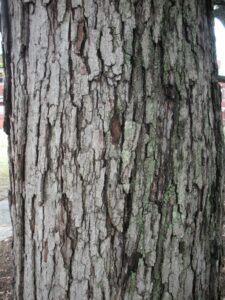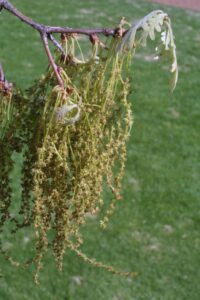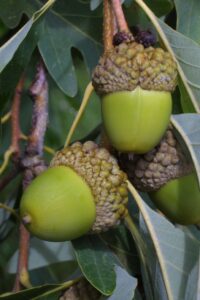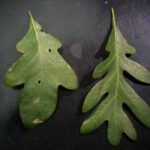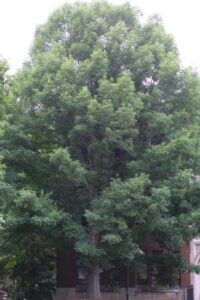Botanical Name:
Quercus alba
Family Name:
Fagaceae
Description:
White oak is a majestic, long-lived deciduous tree, which in open, urban environments will form a short trunk with rounded crown consisting of spreading lower branches and ascending upper branches. When grown in a forested area, the crown will consist mostly of ascending branches. The bark of older trees is a light gray and can vary from ridged and furrowed to scaly with overlapping narrow flat plates. The leaves, which are bright green on the upper surface and whitish underneath, are broadly elliptic or obovate in shape and have pinnate lobing with rounded tips. The oval acorns grow up to an inch long and sit in a shallow cup that covers about a quarter of the acorn body.
Size:
50-100’ tall; 50-80’ spread
Habitat and Range:
Along with northern red oak, white oak is one of the two most abundant oaks species in North America, and it can be the dominant canopy tree in some forests. Its range covers nearly all of eastern North America and adjacent Canada and extends northwest into Wisconsin and southern Minnesota and west as far as eastern Kansas, Oklahoma, and Texas. White oak grows in a many different habitats, such as upland and bottomland woodlands, bluffs, savannas, and high riverbanks. White oak grows best on moist, well-drained soils and does not withstand wet soils.
Attributes:
White oak is one of our best ornamental trees, due to its high wildlife value, its spreading crown that offers abundant shade, and its beautiful fall color of reddish-purple leaves. White oak can tolerate a range of soil conditions, and it displays moderately good drought tolerance due to its deep taproot.
Wildlife Value:
White oaks are a source of food and shelter for a large community of organisms. The species of butterfly and moth larvae that feed on the leaves and wood probably number in the hundreds. Many additional insects, such as beetles, leaf miners, leafhoppers, and aphids also consume white oak tissues. Consequently, the tree is an important source of food for insectivorous birds. The abundant acorns, which are produced annually and lack the bitterness of many other oaks, are eaten by a wide variety of birds and mammals. Cavities in the trunk can be occupied by bats, raccoons, and tree squirrels.
Did you know?
- If you notice the bark of a large white oak changing from rough to smooth along different parts of the trunk, you could be witnessing a condition called smooth patch, which is caused by the fungus Aleurodiscus oaksii. This fungus colonizes the bark and causes the rougher outer layers to slough off. The fungus does not affect the health of the tree, as it does not penetrate the living tissues.
- White oak leaves are familiar to many nature lovers from the logo for The Nature Conservancy.
Benefits to Our Community (based on carbon dioxide sequestered, storm water runoff avoided, and air pollution removed each year):
Over the next 15 years, this tree will give back $3,720 worth of benefits to our community.
